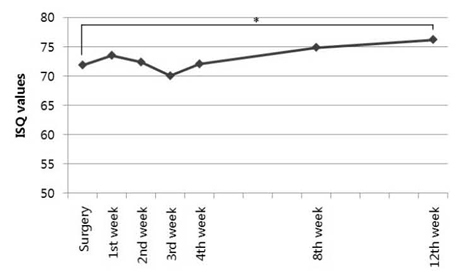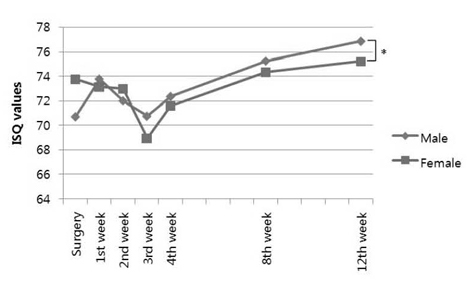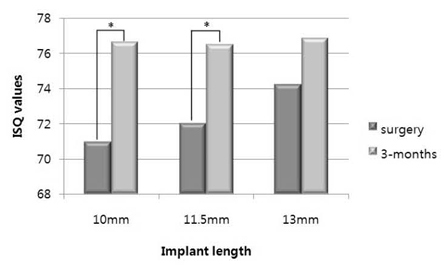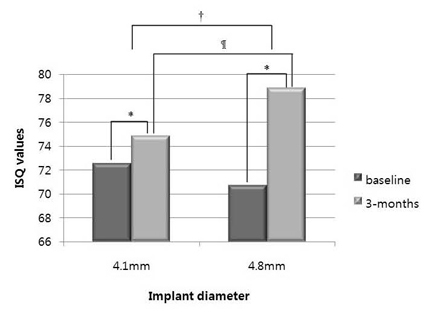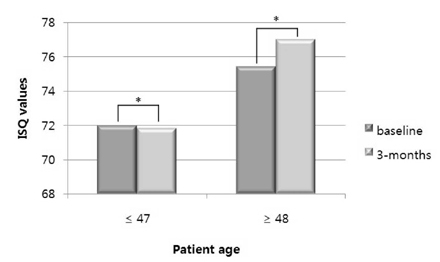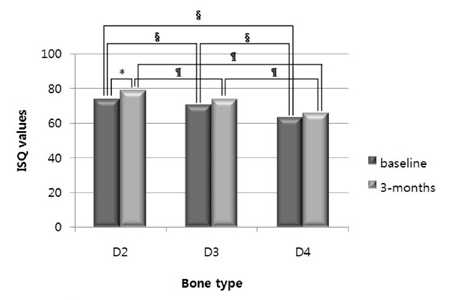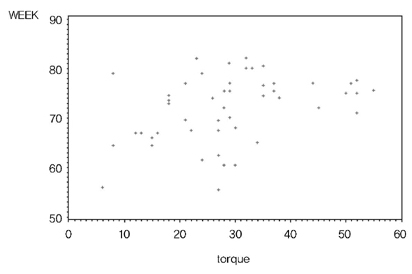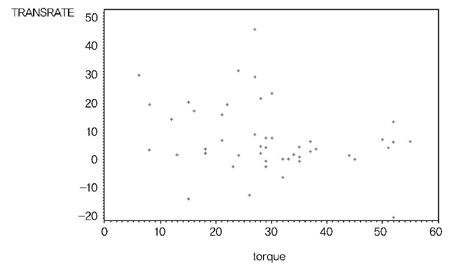J Korean Acad Periodontol.
2009 Sep;39(3):339-348. 10.5051/jkape.2009.39.3.339.
Non-submerged type implant stability analysis during initial healing period by resonance frequency analysis
- Affiliations
-
- 1Department of Periodontology, Graduate School of Medicine, Ewha Womans University, Seoul, Korea.
- 2Department of Periodontology, Research Institute for Periodontal Regeneration, College of Dentistry, Yonsei University, Seoul, Korea. kscho@yuhs.ac
- KMID: 2212148
- DOI: http://doi.org/10.5051/jkape.2009.39.3.339
Abstract
- PURPOSE
The purpose of the present study was to analyze the implant stability quotient(ISQ) values for Korean non-submerged type implant and determine the factors that affect implant stability.
METHODS
A total of 49 Korean non-submerged type implants were installed in 24 patients, and their stability was measured by resonance frequency analysis(RFA) at the time of surgery, and 1, 2, 3, 4, 8, 12 weeks postoperatively. The data for implant site, age, sex, implant length and diameter, graft performing, bone type, and insertion torque were analyzed.
RESULTS
The lowest mean stability measurement was at 3 weeks. There was significant difference between implant placement and 12 weeks. There was significant difference between implant placement and 12 weeks in diameters of 4.1 mm and 4.8 mm. Also, there were significant differences between diameters of 4.1 mm and 4.8 mm at implant placement and 12 weeks after surgery. This result suggests that the factor related to implant diameter may affect the level of implant stability. No statistically significant relationship was found between the resonance frequency analysis and the variables of maxilla/mandible, sex, anterior/posterior, implant length, age of patient, graft performing, bone type, insertion torque during initial healing period.
CONCLUSIONS
These findings suggest that the factor related to implant diameter may affect the variance of implant stability, and ISQ value of implant was stable enough for proved stability level during initial healing period.
Keyword
Figure
Cited by 1 articles
-
Retrospective study of implant stability according to the implant length, diameter and position
Ji-Hye Kim, Jin-Yong Jeon, Yu-Ri Heo, Mee-Kyoung Son
J Korean Acad Prosthodont. 2013;51(4):269-275. doi: 10.4047/jkap.2013.51.4.269.
Reference
-
1. Brånemark PI, Hansson BO, Adell R, et al. Osseointegrated implants in the treatment of the edentulous jaw. Experience from a 10-year period. Scand J Plast Reconstr Surg Suppl. 1977. 16:1–132.2. Aparicio C, Lang NP, Rangert B. Validity and clinical significance of biomechanical testing of implant/bone interface. Clin Oral Implants Res. 2006. 17:Suppl 2. 2–7.
Article3. Koh Young Han, Kim Young Jun, Chung Hyun Ju. Bone Healing around Screw - shaped Titanium Implants with Three Different Surface Topographies. J Korean Acad Periodontol. 2001. 31:41–57.
Article4. Atsumi M, Park SH, Wang HL. Methods used to assess implant stability: current status. Int J Oral Maxillofac Implants. 2007. 22:743–754.5. Meredith N. Assessment of implant stability as a prognostic determinant. Int J Prosthodont. 1998. 11:491–501.6. Choi Hyun Suk, Chung Hyun Ju, Kim Ok Su, Kim Young Jun. The study on the survival rates and crestal bone changes around the implants. J Korean Acad Periodontol. 2004. 34:303–315.
Article7. Oh Jun-ho, Chang Moontaek. Comparison of initial implant stability measured by Resonance Frequency Analysis between different implant systems. J Korean Acad Periodontol. 2008. 38:529–534.
Article8. Sykaras N, Triplett RG, Nunn ME, Iacopino AM, Opperman LA. Effect of recombinant human bone morphogenetic protein-2 on bone regeneration and osseointegration of dental implants. Clin Oral Implants Res. 2001. 12:339–349.
Article9. Meredith N, Alleyne D, Cawley P. Quantitative determination of the stability of the implant-tissue interface using resonance frequency analysis. Clin Oral Implants Res. 1996. 7:261–267.
Article10. Meredith N. Assessment of implant stability as a prognostic determinant. Int J Prosthodont. 1998. 11:491–501.11. Brånemark PI. Osseointegration and its experimental background. J Prosthet Dent. 1983. 50:399–410.
Article12. Buser D, Mericske-Stern R, Dula K, Lang NP. Clinical experience with one-stage, non-submerged dental implants. Adv Dent Res. 1999. 13:153–161.
Article13. Szmukler-Moncler S, Piattelli A, Favero GA, Dubruille JH. Considerations preliminary to the application of early and immediate loading protocols in dental implantology. Clin Oral Implants Res. 2000. 11:12–25.
Article14. Degidi M, Piattelli A. Immediately loaded bar-connected implants with an anodized surface inserted in the anterior mandible in a patient treated with diphosphonates for osteoporosis: a case report with a 12-month follow-up. Clin Implant Dent Relat Res. 2003. 5:269–272.
Article15. Barewal RM, Oates TW, Meredith N, Cochran DL. Resonance frequency measurement of implant stability in vivo on implants with a sandblasted and acid-etched surface. Int J Oral Maxillofac Implants. 2003. 18:641–651.16. Roberts WE. Bone tissue interface. J Dent Educ. 1988. 52:804–809.
Article17. Bischof M, Nedir R, Szmukler-Moncler S, Bernard JP, Samson J. Implant stability measurement of delayed and immediately loaded implants during healing. Clin Oral Implants Res. 2004. 15:529–539.
Article18. Huwiler MA, Pjetursson BE, Bosshardt DD, Salvi GE, Lang NP. Resonance frequency aalysis in relation to jawbone characteristics and during early healing of implant installation. Clin Oral Implants Res. 2007. 18:275–280.
Article19. Abrahamsson I, Berglundh T, Linder E, Lang NP, Lindhe J. Early bone formation adjacent to rough and turned endosseous implant surfaces. An experimental study in the dog. Clin Oral Implants Res. 2004. 15:381–392.
Article20. Brochu JF, Anderson JD, Zarb GA. The influence of early loading on bony crest height and stability: a pilot study. Int J Prosthodont. 2005. 18:506–512.21. Boronat Lopez A, Balaguer Martinez J, Lamas Pelayo J, Carrillo Garcia C, Penarrocha Diago M. Resonance frequency analysis of dental implant stability during the healing period. Med Oral Patol Oral Cir Bucal. 2008. 13:244–247.22. Zix J, Kessler-Liechti G, Mericske-Stern R. Stability measurements of 1-stage implants in the maxilla by means of resonance frequency analysis: a pilot study. Int J Oral Maxillofac Implants. 2005. 20:747–752.23. Ostman PO, Hellman M, Wendelhag I, Sennerby L. Resonance frequency analysis measurements of implants at placement surgery. Int J Prosthodont. 2006. 19:77–83.24. Turkyilmaz I, Aksoy U, McGlumphy EA. Two alternative surgical techniques for enhancing primary implant stability in the posterior maxilla: a clinical study including bone density, insertion torque, and resonance frequency analysis data. Clin Implant Dent Relat Res. 2008. 10:231–237.
Article25. O'Sullivan D, Sennerby L, Meredith N. Measurements comparing the initial stability of five designs of dental implants: a human cadaver study. Clin Implant Dent Relat Res. 2000. 2:85–92.26. Ersanli S, Karabuda C, Beck F, Leblebicioglu B. Resonance frequency analysis of one-stage dental implant stability during the osseointegration period. J Periodontol. 2005. 76:1066–1071.
Article27. Valderrama P, Oates TW, Jones AA, et al. Evaluation of two different resonance frequency devices to detect implant stability: a clinical trial. J Periodontol. 2007. 78:262–272.
Article28. Sennerby L, Meredith N. Implant stability measurements using resonance frequency analysis: biological and biomechanical aspects and clinical implications. Periodontol 2000. 2008. 47:51–66.
Article29. Friberg B, Sennerby L, Linden B, Grondahl K, Lekholm U. Stability measurements of one-stage Branemark implants during healing in mandibles. A clinical resonance frequency analysis study. Int J Oral Maxillofac Surg. 1999. 28:266–272.
Article30. Glauser R, Sennerby L, Meredith N, Ree A, Lundgren A, Gottlow J, et al. Resonance frequency analysis of implants subjected to immediate or early functional occlusal loading. Successful vs. failing implants. Clin Oral Implants Res. 2004. 15:428–434.
Article31. Nedir R, Bischof M, Szmukler-Moncler S, Bernard JP, Samson J. Predicting osseointegration by means of implant primary stability. Clin Oral Implants Res. 2004. 15:520–528.
Article
- Full Text Links
- Actions
-
Cited
- CITED
-
- Close
- Share
- Similar articles
-
- Comparison of initial implant stability measured by Resonance Frequency Analysis between different implant systems
- The influence of implant diameter, length and design changes on implant stability quotient (ISQ) value in artificial bone
- A comparative study on the initial stability of different implants placed above the bone level using resonance frequency analysis
- A comparison of the implant stability among various implant systems: clinical study
- A resonance frequency analysis of sandblasted and acid-etched implants with different diameters: a prospective clinical study during the initial healing period

